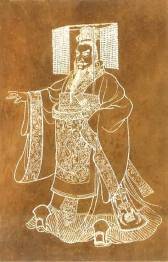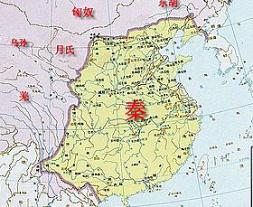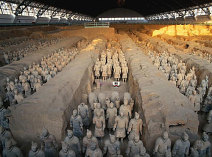
China Overview
- Population: 1.3 billion
- Currency: yuan
- Guinness World Records: most people painting each other's faces simultaneously in one location (13,413), largest bottle of cooking oil (containing 3212 litres), most couples hugging (3009 couples).
- Internet users: 135 million
- Milk beer: from Inner Mongolia, an alternative to the traditional mare's-milk wine.
- Squirrel fish: whole mandarin fish deep-fried and manipulated to resemble a squirrel.
- Number of chinese characters: over 56,000
Qin Dynasty
Qin was the first centralized, unified, and multi-ethnic feudal dynasty in Chinese history. The Qin Dynasty was the dynasty that redefined China and made China a unified nation. |
| How did Qin Dynasty emerge? Originally, the Qin people were an ancient tribe in western China. During the rule of King Xiao of the Zhou Dynasty (11th century BC - 221 BC), Feizi, chief of the Qin tribe, raised horses for the king who then gave Feizi the surname of Ying. Later, Duke Zhuang, another chief of the Qin tribe, received orders from King Xuan to fight against the Quanrong who were badly defeated during the war. Thereafter, the Qin tribe gradually became more powerful.
|
|
In the later times of the Western Zhou Dynasty (11th century BC - 771 BC), Duke Xiang of the Qin tribe was conferred as a vassal along with the land of Qixi (today’s Baoji City, Shaanxi Province) by King Ping, because he had made contributions to escort King Ping to move east. | |
Who was the first emperor of Qin Dynasty? In 221 BC, Ying Zheng, the king of the State of Qin, a man of great talent and bold vision ended the Warring States Period and unified the country. He made Xianyang City of Shaanxi Province as the capital and called himself Qin Shi Huang ("First Emperor of Qin"). |
| What were the achievements of Qin Shi Huang ("First Emperor of Qin")? | |
 | Politics |
Economy The First Qin Emperor standardized the length, measures and weights, and unified the currency, which promoted the economical communications among different ethnic groups regions. It conveniently provided opportunities for social and economic development. Culture The First Qin Emperor unified the characters by making the mini-seal scripts as the official ones, which promoted cultural communications. However, in order to reinforce control over the people's ideas, he ordered the burning of all historical books, literary works and poems collected by the Chinese people, only leaving medical books, books of auguring, crops books, and the books about the Qin State. Furthermore, the First Emperor of Qin buried 460 men of letters alive, because some shamans and scholars had secret discussions about his absolutism, covetousness of power, and excessive punishment. That is the well-known event – “Burn the books and bury the scholars alive”. |
| ||||
All Topics about China
- General-China-Introduction
- C2-Chinese-History
- Chinese-Religions
- Chinese-Food-and-Drink
- Chinese-Literature
- Chinese-Nationality
- Chinese-Architecture
- Chinese-Arts-and-Crafts
- Chinese-Language-and-Education
- Chinese-Medicine
- Chinese-Transportation
- Chinese-Festival
- Chinese-Astrology-and-Zodiac
- Chinese-Calendar
- Chinese-Traditional-Sports-&-Activities
- Chinese-Martial-Arts
HOTMost Popular Topics
Climate in China
Because of its size, China has great climatic diversity. Generally, the best time to visit China is during spring and autumn.
Chinese-Language-and-Education
Chinese is the most commonly used language in China, and one of the most commonly used languages in the world.
Chinese-Festival
China has many traditional festivals, including the Spring Festival, the Lantern Festival, the Dragon Boat Festival.
Chinese Chinese-Astrology-and-Zodiac
In the Chinese zodiac, twelve animals are used to denote the year of a person's birth: rat, ox, tiger, rabbit, dragon.
History of China
China, one of the world's most ancient civilizations, has a recorded history of nearly 4,000 years..









